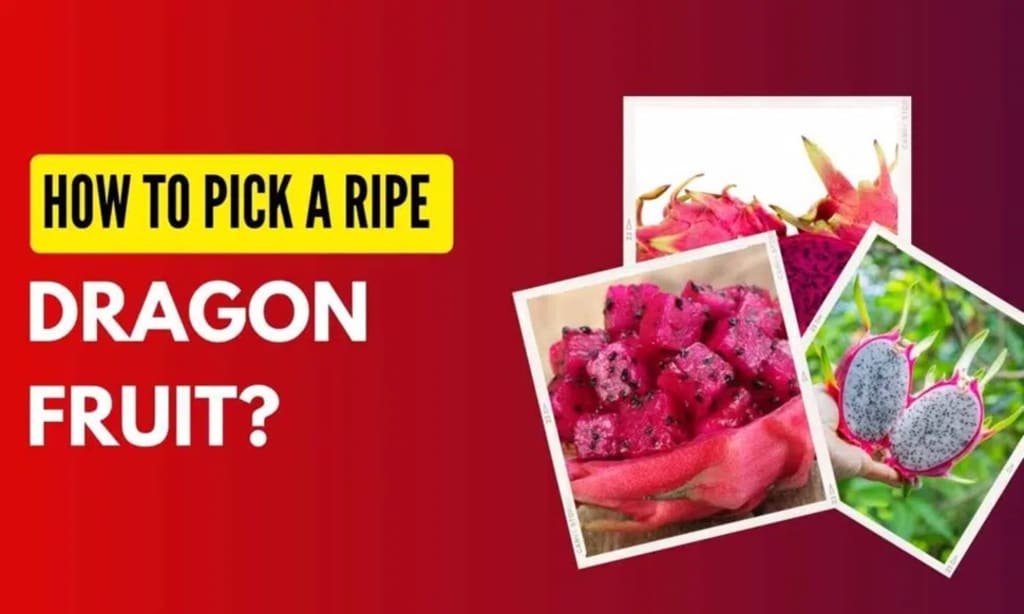How to Pick a Ripe Dragon Fruit?
How to Pick a Ripe Dragon Fruit?

Title: How to Pick a Ripe Dragon Fruit: A Guide to Choosing the Best Ones
Introduction:
Dragon fruit, also known as pitaya, is a tropical fruit renowned for its vibrant appearance and refreshing taste. However, picking the perfect dragon fruit can be a bit tricky, especially for those unfamiliar with its unique characteristics. In this guide, we'll delve into the art of selecting ripe dragon fruit to ensure you enjoy the juiciest and most flavorful experience.
Understanding Dragon Fruit Varieties:
Before diving into the selection process, it's essential to familiarize yourself with the two main varieties of dragon fruit: the red-fleshed and white-fleshed varieties. Red-fleshed dragon fruit, often referred to as Hylocereus undatus, features a vibrant pink or red interior with black seeds. On the other hand, the white-fleshed variety, known as Hylocereus costaricensis or Hylocereus megalanthus, boasts a sweeter taste and a pale white interior speckled with black seeds.
Now, let's explore the key indicators of ripeness for both types of dragon fruit:
1. Color:
- Red-fleshed dragon fruit: A ripe red-fleshed dragon fruit typically displays vibrant shades of pink or red on its skin. Look for fruits with uniform coloration, avoiding any green patches, as they indicate underripeness.
- White-fleshed dragon fruit: Ripe white-fleshed dragon fruit tends to have a golden-yellow hue on its skin. Similar to the red-fleshed variety, opt for fruits with consistent coloring and avoid those with prominent green patches.
2. Texture:
- Gently squeeze the dragon fruit. A ripe fruit should yield slightly to pressure without feeling too soft or mushy. Avoid fruits that are excessively firm or overly soft, as they may be underripe or overripe, respectively.
3. Firmness:
- Press your fingertips against the skin of the dragon fruit. A ripe fruit should have a slight firmness, indicating juiciness. However, it shouldn't feel rock-hard, as this could signify underripeness.
4. Appearance of Scales:
- Examine the scales or spikes on the surface of the fruit. Ripe dragon fruit typically has scales that are well-defined and evenly spaced. Avoid fruits with shriveled or wilted scales, as they may be past their prime.
5. Fragrance:
- While dragon fruit is not known for its strong aroma, a ripe fruit may emit a subtle, sweet fragrance near the stem end. However, keep in mind that the scent may vary depending on the variety and ripeness stage.
6. Stem Condition:
- Check the stem or the remnants of where the stem was attached. A ripe dragon fruit should have a dry, withered stem without any signs of mold or excessive moisture. A fresh-looking stem indicates that the fruit was harvested prematurely.
7. Size and Weight:
- Although size can vary depending on the variety, choose dragon fruits that feel heavy for their size. Heavier fruits often indicate higher water content and juiciness, which are indicative of ripeness.
4. Appearance of Scales:
- Examine the scales or spikes on the surface of the fruit. Ripe dragon fruit typically has scales that are well-defined and evenly spaced. Avoid fruits with shriveled or wilted scales, as they may be past their prime.
5. Fragrance:
- While dragon fruit is not known for its strong aroma, a ripe fruit may emit a subtle, sweet fragrance near the stem end. However, keep in mind that the scent may vary depending on the variety and ripeness stage.
6. Stem Condition:
- Check the stem or the remnants of where the stem was attached. A ripe dragon fruit should have a dry, withered stem without any signs of mold or excessive moisture. A fresh-looking stem indicates that the fruit was harvested prematurely.
7. Size and Weight:
- Although size can vary depending on the variety, choose dragon fruits that feel heavy for their size. Heavier fruits often indicate higher water content and juiciness, which are indicative of ripeness.
Conclusion:
Selecting a ripe dragon fruit is a skill that improves with practice and experience. By paying attention to the fruit's color, texture, firmness, appearance of scales, fragrance, stem condition, and size, you can increase your chances of picking a deliciously ripe specimen. Whether you prefer the vibrant red flesh or the sweet white flesh variety, the key is to choose fruits that exhibit the telltale signs of ripeness. So next time you're at the market or grocery store, use these guidelines to select the perfect dragon fruit and savor its exotic flavor to the fullest.
About the Creator
Kavya Organic Garden
Passionate about home gardening, plant care, growth, and maintenance. Join me on this exciting journey of organic practices and sustainable gardening! 🌱






Comments
Kavya Organic Garden is not accepting comments at the moment
Want to show your support? Send them a one-off tip.